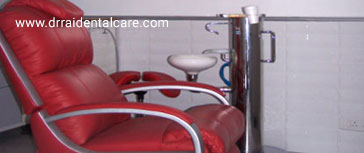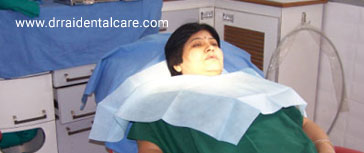

Implants are devices that replace the roots of missing teeth, and are used to support crowns, bridges or dentures. Implants are placed in your jawbone surgically. Most of the time, implants feel more natural and secure than other methods of replacing missing teeth, such as dentures.
Replacing a lost tooth is vital to maintaining the overall health and function of the surrounding teeth. It helps avoid tooth migration and loss of structure. It is necessary to avoid loss of bone from the jaw in that area. Having all of your teeth can make you more self-confident. You don't worry that people notice that you have teeth missing.
When teeth are lost, the area of the jawbone that held those teeth starts to erode. Over time, you can lose so much bone that your jaw will need a bone graft to build up the bone in your jaw before your dentist can place implants or make a denture that fits properly. Tooth loss affects how well you chew and what foods you are able to eat. Many people who have missing teeth have poor nutrition, which can affect overall health.
The loss of teeth can change your bite, that is the way your teeth come together. Changes in your bite can lead to problems with your jaw joint, called the temporomandibular joint. Losing teeth can lead to changes in your speech, which also can affect your self-confidence.
Dental implants are an effective means of counteracting these problems. Dental implants are also very strong and provide a feel as close to a natural tooth as can be currently achieved. Further, implants reduce the impact of the lost tooth on surrounding teeth, as traditional bridge structures often require reduction (filing down) of the two adjacent teeth to hold the bridge in place with crowns. Implanting avoids such alterations to the surrounding teeth when replacing a lost tooth.
Dental implants, when replacing dentures, provide even more benefits. Dentures are notorious for slipping at the worst possible moments. Poorly fitting dentures can even affect diet, restricting food selections to easily chewed foods.
Implants eliminate the possibility of slipping or pinching, and allow food of almost all types to be eaten (other than extremely hard foods such as chewing on ice, pits, or popcorn kernels, which is very bad for the implants and not good for natural teeth, either). In short, dental implants are the closest way to surgically restore a natural tooth to its original condition
Depending on your particular problem, implants can be more expensive than the alternatives (denture or bridge).While the upfront cost for implants can be more than for other types of restorations, the investment can pay off in the long run. You do not necessarily need an implant for every missing tooth. Your dentist can discuss how many implants you will need .Other benefits of implants include: Feel - Because implants are imbedded in your bone, they feel more like your natural teeth than bridges or dentures.
Convenience - You will not need to worry about denture adhesives or having your dentures slip, click or fall out when you speak.
Nutrition - You will be able to chew better with implants. Chewing can be difficult with regular dentures, especially ones that don't fit perfectly. A regular upper denture also covers your palate, which can reduce your sense of taste.
Self-esteem - Because implants are so much like your natural teeth, you will think about them less. Your self-esteem and confidence will be improved because you will not have to worry about denture problems or people noticing that you have missing teeth. Regular dentures also can affect your speech, which can make you less self-confident when talking with others.
At the first appointment, the dentist will examine your teeth and determine whether implants are the solution to your dental problems. Often, x-rays are necessary to discover the state of the jawbone, particularly if the teeth have been lost for some time. Dentist may even make dental models for better understanding.This information can be used to determine if implants would work for you and, if so, what particular type of implant that would be best for your situation.
Under local anesthesia, the first step for many implant procedures is the exposure of the bone where the implant is to be made. This is followed by placement of the implant into the exposed jawbone. Implants that are placed in the bone are called endosteal implants and are made of titanium or a titanium alloy because this metal does not adversely interact with biological tissue.
After placement of the implant a cover screw is put in and the wound is closed with stitches and allowed to heal. In general, placements in the lower jaw need to heal about three months, while placements in the upper jaw need to heal about six months. After healing, in a second surgical procedure, the implant is uncovered, the cover screw is removed and a healing abutment or a temporary crown is placed in the implant. Temporary crowns are generally used for esthetic reasons, when the implant is in a place that is visible. Both healing abutments and temporary crowns allow the tissue around the implant to be trained to grow around the final prosthetics tooth. After about two months the soft tissue will be healed to receive the final prosthetic tooth.
Impressions are taken to make a custom abutment that takes into account the shape of the neck of the implant. The prosthetic tooth is sometimes attached to a cylinder that can be screwed into the abutment or it can be directly cemented onto the abutment. This multi-stage process, where the two surgical procedures are separated by a lengthy healing time, has proven to provide excellent stability in the final implant.
Single step surgical implants are available, but skipping the healing step often loses some stability of the final implant.Immediate placement with instant crown has specific indications and may not suit every patient.
Surgery time will vary greatly depending on the number of dental implants. For each of the two visits, one implant, going very smoothly, will take a little over an hour. Time goes up proportionally from there.
The implant procedure generally occurs in the office of a dentist,and doesn't require special operation theatre.Though specialized equipment like physiodispensor, is needed with good sterilization control.
Local anesthesia avoids the pain that would be involved in the surgical procedures during implantation and uncovering of the implant fixture. Most patients state that implants involve less pain and discomfort than a tooth extraction
Following surgery, there will probably be some or no bleeding, controlled by biting down on some gauze. Swelling may be controlled using an ice pack. Gums are generally sore after both surgeries for seven to ten days. You may be given antibiotics to take during the period immediately following the surgery.
Many people have very mild soreness, bleeding, or swelling, which can be treated with first aid and over the counter medicines and can return to work the day after surgery.
In between the first and second surgery, there is a recovery period of three to six months while the implants associate with the bone. This growth of the bones around the titanium posts may induce a few weeks of soreness. This discomfort can usually be controlled using over the counter medicine.
It is very important during your recovery to practice scrupulous oral hygiene. Poor care, resulting in chronic swelling of gum tissue, is a major contributor to implant failure. You may need to see your dentist about four times a year to keep track of the implant health
For most people, dental implants last between fifteen and twenty-five years. They may last significantly longer, but implantation is a new procedure and data has not been gathered. Between about 5 and about 10% of implants fail, but they often can be replaced with another implant attempt.
The primary consideration for the suitability of dental implants for a particular patient is the amount and condition of the bone in the area where the implant is to be placed. With the loss of a tooth, the area of the jaw without the tooth naturally undergoes resorption, or a thinning, of the bone in that area. The less bone available in which to place the implant, the greater chance of the implant not "taking" in the region. A common type of implant, called root form implants due to their similarity in shape to a tooth root, actually undergo a bonding with the surrounding bone called Osseo integration. Without enough healthy bone at the implant site, this process cannot occur and the implant will fail.
There are two solutions commonly used for highly resorbed bone in the area where the implant is to occur. The first is bone grafting. This involves undergoing a procedure that moves bone from one place in the body to another to enlarge the bone structure at the implant site. Often bone can be moved from one place in the mouth to another. Sometimes a graft from a donor or an animal or artificial bone can be used if bone from the patient is not available. Grafting usually is done four to eight months before the implant procedure, to allow the graft a chance to heal before it is disturbed with the implant process.
A further consideration as to suitability for implants is the patient's general health, especially whether or not the patient smokes. Although the exact cause of the connection is not known, dentists hypothesize that the nicotine in the cigarettes, known to shut down blood vessels, interferes with the healing of the dental implants. Whatever the cause, heavy smokers are known to have a higher failure rate for implants than those who do not smoke. Other chronic conditions that affect healing, such as cardiovascular diseases, diabetes, and immunosupression can also increase the chance of implant rejection.
The greatest risk following the surgical procedures is that the implant will fail. For implants placed within the bone, most failures occur within the first year and then occur at a rate of less than one percent per year thereafter. Location of the implant can also predict the risk of failure. Implants in the back upper jaw fail most often, followed by the front upper jaw, the back lower jaw, and the most success seen in implant of the front lower jaw. Overall, the success rate for all implants runs from 90 to 95%. Most failed implants can be replaced with a second attempt.
Implants can be a very expensive procedure, particularly if a number of them are needed to restore the teeth lost by the patient.
In United States and Europe , a single tooth implant costs between about $1500 to about $4000(i.e Rs 60,000-1,60,000). Full sets of implanted teeth can run as high as $30,000. In general, insurance does not cover the cost of implants.
However, in India, the costs range from Rs 25000-50,000 per implanted unit as per the implant type.
(less expensive options are UNITI ,kos, ;moderately expensive are ALPHABIO and HI-TEC the most expensive options are ENDOPORE,NOBELBIOCARE,BIOCON IMPLANTS).Implant patients generally say that the results that were obtained were worth the cost of the procedure.
Carefully follow any instructions your dentist gives you.